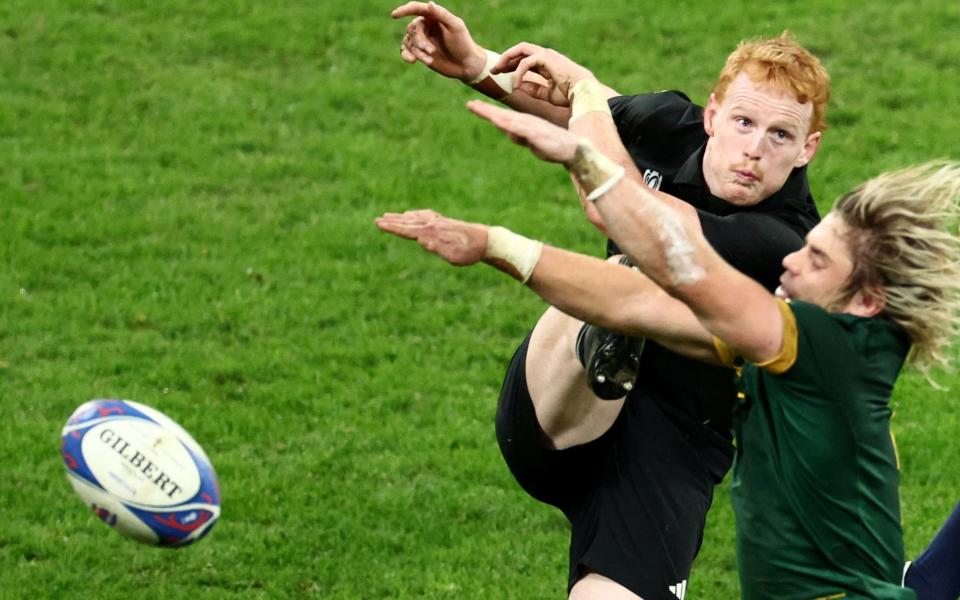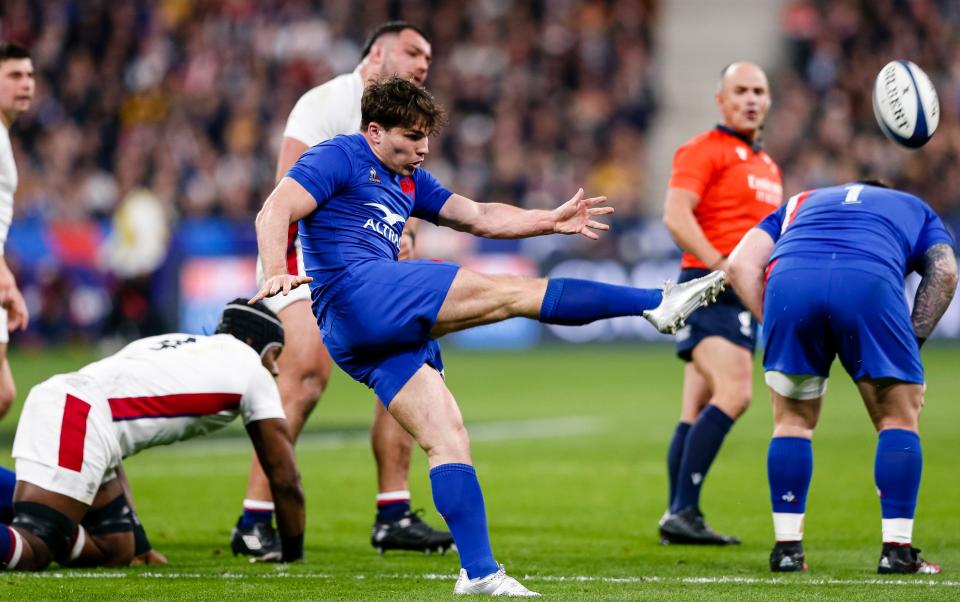The truth about kicking: Analysts can prove ‘the smartest teams’ rely on it

Rugby’s thorny issue has never been thornier. Nothing divides opinion like the concept of kicking in open play: the rationale, the prevalence and its art.
No matter which side of the fence you fall, there are two undeniables: rugby has developed into a sport where, rightly or wrongly, the most efficient way of gaining territory is through kicking; concurrently, there is far less kicking in the modern game than there was in the amateur equivalent.
For starry-eyed nostalgists longing for a return to the amateur era, here are two killer statistics: at the 2023 World Cup, there were roughly 30 per cent fewer kicks per minute than in the 1987 edition; and in the classic 1973 match between the Barbarians and New Zealand there were 106 kicks in open play. The highest total for a match at rugby’s showpiece in France last year was 82.
Despite that – no matter what the rugby hipsters will have you believe – in terms of pure theatre there is no contest between the launching of a counter-attack and a bout of kick-tennis, such as the extreme example widely ridiculed in Bath’s Premiership victory against Gloucester. There is immense skill involved in those exchanges, of course, but no fan in good faith could say they would prefer to watch a kicking episode over the rapid regality of a Dupont-Ramos counter.
Bath very in tune with the Dupont loophole that states you can advance from an offside position once a catcher has travelled five metres.
When Will Muir finally does get a charge-down, though, Gloucester benefit from the ricochet.
Please can we close the loophole? It's trash. pic.twitter.com/PZAao1Spvk— Charlie Morgan (@CharlieFelix) January 7, 2024
The crux is that kicking has become a symptom of modern rugby’s issues, not a cause. Players choose to put boot to ball because the game has become one in which such an action is crucial; they are not doing it because they want to or out of force of habit. The most fashionable of proposed law changes all aim to reduce kicking in isolation, such as banning caterpillar rucks or speeding them up, but those proposals fail to address the root cause.
Kicking is by far the best way to progress up the pitch
Rugby has developed into a sport whereby it is far too risky to play with the ball in hand in your own half; even outside the opposition 22. For proof, we turn to Oval, the industry-leading analysts who have worked with both England and the Premiership. The agency has exclusively shared research with Telegraph Sport outlining rugby’s imbroglio.
Last season, more than half of tries scored in men’s “Tier One” Tests came from possession starting in the attacking 22; and 90 per cent of those were from line-outs, scrums and tap-penalties. Simultaneously, defences have never been better: at the 1987 World Cup, roughly 30 per cent of tackles were missed; in 2023 it was just 13.
With modern defences as strong as they are, kicking has become by far the most fruitful method of progressing up the pitch to the opposition 22 where, as outlined by Oval, tries are far more likely to be scored.
Rugby’s problem is that, as research shows, the chasm becomes wider as you progress up rugby’s ladder of competition. In 2023, the win percentage for a team making more carry metres than the opposition across the world’s second tiers – the likes of the Championship and the French Pro D2 – was over 67 per cent. One step above in the ladder – the Premiership and the Top 14 among others – was just over 66. Then, at ‘Tier One’ international level, it was just over 58 per cent. Conversely, the win percentage for a team with more kick metres at Test level in the same period was over 78 per cent; at Premiership level it was over 66 per cent, while the step below was 64 per cent. At Test level, the winning side also earn far more turnovers: at the 2023 Rugby World Cup, the attack was penalised more often at the ruck than the defence (219 v 213).
‘The smartest teams realise this’
“The World Cup has almost always been won by the team with the best kicking and defence,” James Tozer, co-founder of Oval, says. “If you look at knockout matches, there is a strong correlation between winning games, kicking the ball more often and snaffling more turnovers. There is almost no correlation between winning knockout games and line breaks, or carry metres, or possession.
“England in 2003 are a great example. They only scored three tries in four matches against “Tier One” opposition, but were brilliant in those less glamorous areas of the game. This is also why South Africa have won four World Cup finals, despite scoring a try in only one of them – they know what wins knockout matches.
“The smartest teams today have realised this. France have a whole team of data scientists – and in the last two years of Tier One Tests, they have kicked the ball more often and further than anyone else, as well as conceding fewer turnovers. This season in the Premiership, an underreported part of Northampton’s surge to the top of the table is that they have also kicked more often and further than anyone else (as well as having the second-fewest turnovers).

“In modern international rugby, with the current laws, trying to beat an elite defence purely by carrying the ball is a bit like fighting a trench war on horseback, especially if the weather is grim and the terrain is slippery. You need to have other weapons at your disposal. You’ve got kicking, which is your artillery; and you’ve got set-piece, which is your tanks. Of course, a good attack is important, but you cannot just turn up with the cavalry and expect to win. Despite all of this, there are more tries being scored in Tier One Tests than at any point in history, because teams have gotten smarter at gaining territory and then exploiting it.”
To reduce kicking, therefore, certainly at international level, it has to become more attractive for teams to play with the ball in hand outside the opposition 22. But how?
Do not hate the player … hate the game
Creating more space is the crude response but, again, aside from increasing the size of the pitch, how is that achieved? Oval believes one successful solution could be reducing the number of players – and they can prove it.
Obviously, sevens features much less kicking due to having far fewer players, but where Oval has crunched the numbers is in the sundry examples of matches in the 15-player game that have been reduced to 14-a-side owing to indiscipline.
Across 2022 and 2023 in the world’s elite competitions – including the men’s World Cup – 14 against 14 had six per cent fewer kicks per possession and 28 per cent more tries. There was also a sharp increase in unsuccessful tackles – from 20.5 per cent to 22.44 per cent – likely a result of defences being more stretched.
Rather than a permanent switch to 13 or 14 players that would reset the fabric of the sport, one possible innovation could be to introduce a T20/ODI-style “powerplay” at international level, mirroring limiting the number of fielders on the boundary at the start of an innings to incentivise attacking play.
Whichever path rugby takes, the data is clear: the sport has more tries and fewer kicks than ever, but its fabric is inhibiting progression and encouraging a lack of ball-in-hand audacity.
The words of Oval, at the cutting edge of the sport, should be heeded sooner rather than later. Until fundamental change comes, do not hate the player; hate the game.

 Yahoo Sport
Yahoo Sport 






































